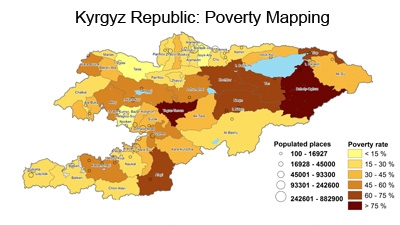Bishkek, April 18, 2013 – There is significant variation in poverty across oblasts but also within them, according to a set of studies released this week in Bishkek by the World Bank Group. Working with the National Statistical Committee, the Bank’s poverty research team created a Kyrgyz Republic Poverty Map, which provides poverty estimates at the rayon level for 2009, ranging from 6 to 80 percent. This level of disaggregation was possible, since in the same year, the government conducted both the household survey and the census—two main sources of data needed to calculate sub-oblast poverty analysis. The poverty map provides a valuable snapshot of the population’s welfare situation in a country at one point in time. It should be noted, however, that recent changes in poverty are not reflected in the 2009 poverty map.
The Regional Welfare Disparities in the Kyrgyz Republic report questioned whether the differences in levels of prosperity in the country are due to the differences in peoples’ characteristics or where they live. People with higher education, full-time employment, and fewer dependents are considered to have more favorable characteristics in terms of income earning potential. Comparing Bishkek to the rest of the country, the analysis showed that the capital has lower poverty rates, in part because its population has more favorable characteristics. But the population is also better off because of some unknown factors that could be related to its relatively more dynamic market, good infrastructure, and accessible social services. The study also found that the differences in poverty rates in the rest of the country cannot be explained by the characteristics of people.
The Market Accessibility and Regional Maps study explored the population’s access to market since it is closely linked to their economic opportunities and living standards. Peoples’ market accessibility is high when they live close to large population centers and have access to good quality roads. The study overlaid the poverty map with a market accessibility map, thus, illustrating the linkage between market access and poverty at the rayon level. In the Kyrgyz Republic, poverty rates appear significantly lower in rayons where people have high market access such as in Bishkek and Chui oblast. A good transportation network links the population to jobs and markets but also to social services which enhance the quality of life. The study employed Geographic Information Systems (GIS) technology to construct a market access indicator by combining road network and population data.
“Kyrgyz Republic is an important case to study welfare disparities because of pronounced and long existed differences across oblasts and rural and urban areas of the country in spite of economic growth and overall poverty reduction,” said Sarosh Sattar, the team leader of the poverty analysis program in the Kyrgyz Republic. “For instance, once we exclude Bishkek from our computations, we find that urban and rural poverty rates have converged to 40 percent in 2011, according to the household budget survey data collected by Kyrgyz National Statistical Committee. The welfare disparities are greatest between the growing capital Bishkek and the other regions. Thus, for example, the poverty in the Naryn region is 50 percent versus 18 percent in the capital.”
The research was the first of its kind, aiming to explain welfare disparities in a country from the Central Asian region where the urban rural gap is an important component of inequality. The results emphasized the importance of multiple factors in explaining welfare differences both within and between the regions. Therefore, having a balanced policy of investing in the poor’s human capital and upgrading the infrastructure of lagging regions increases economic opportunities.
“Ensuring equal access to basic public services of similar quality (such as spatially blind institutions as health, education, water) regardless of the place of residence is also important to equalize the opportunities across areas. This will ensure that more even prosperity throughout the country,” said Sattar.
The analysis in these studies was based on the data from the Kyrgyz Integrated Household Survey (KIHS) for 2011, which was collected and made available to the World Bank by the National Statistical Committee of the Kyrgyz Republic. The sample of the survey is nationally representative.
This research was generously supported by the UK Department for International Development.

